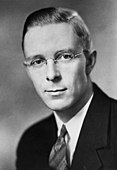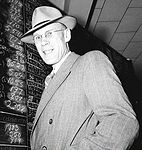Alberta general election, 1948
|
|
|||||||||||||||||||||||||||||||||||||||||||||||||||||
|---|---|---|---|---|---|---|---|---|---|---|---|---|---|---|---|---|---|---|---|---|---|---|---|---|---|---|---|---|---|---|---|---|---|---|---|---|---|---|---|---|---|---|---|---|---|---|---|---|---|---|---|---|---|
|
|||||||||||||||||||||||||||||||||||||||||||||||||||||
|
|
|||||||||||||||||||||||||||||||||||||||||||||||||||||
|
57 seats in the Legislative Assembly of Alberta 29 seats were needed for a majority |
|||||||||||||||||||||||||||||||||||||||||||||||||||||
|
|||||||||||||||||||||||||||||||||||||||||||||||||||||
|
|||||||||||||||||||||||||||||||||||||||||||||||||||||
The Alberta general election of 1948 was the eleventh general election for the Province of Alberta, Canada. It was held on August 17, 1948 to elect members of the Legislative Assembly of Alberta.
Ernest C. Manning led the Social Credit to a fourth term in government, increasing its share of the popular vote further above the 50% mark it had set in the 1944 election. It won the same number of seats — 51 of the 57 seats in the legislature — that it had won in the previous election.
The remaining seats were won by the Cooperative Commonwealth Federation, the Liberal Party and independents.
Along with this election, voters got to also vote in a province wide plebiscite. The ballot asked voters about utility regulation.
Note:
* Party did not nominate candidates in the previous election.
The electrification plebiscite was possibly the third plebiscite conducted province-wide in Alberta's history. The ballot was not a traditional yes/no question, but presented two options on electricity regulation, asking if the province should create a Crown corporation to manage electricity, or leave the electricity industry in the hands of the companies currently in the business (a mixture of municipal operations and private companies).
The result shows how evenly divided the province was on the issue, with a plurality of only 151 votes in favour of leaving the old system in place. In fact, the majority of voters in Edmonton and in the rural areas were in favour of provincial control but an even larger majority in Calgary voted in favour of the old system.
...
Wikipedia


